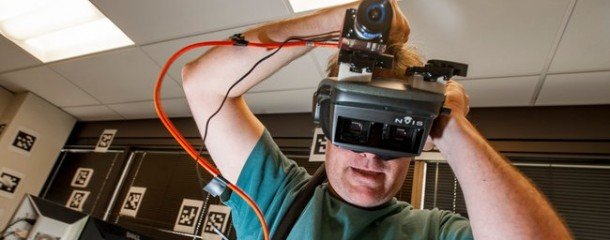Valve's Michael Abrash on the problems of screen resolution in VR headsets

Over at the Valve Time blog , Michael Abrash has posted an in-depth examination of the effect that screen resolution will have on virtual reality headsets. Valve's wearable computing wizard recalls the ancient times (or, as they known back then, the mid-90s), when games like Quake could run at a dizzying 640x480 display. The point of this reminiscing is to highlight that the public's perception of graphical size and fidelity is all relative.
A 640x480 display looked great at the time, but to our modern sensibilities, when Steam's own hardware survey tells us that the majority of its users are sporting 1920x1080 monitors, it would look downright offensive. We've tasted the future, and there's no going back. Abrash argues that the same theory applies to VR.
At first glance, the news is positive. "The first generation of consumer-priced VR head-mounted displays is likely to top out at 960×1080 resolution," Abrash writes, "for the simple reason that that's what you get when you split a 1080p screen across two eyes, and 1080p is probably going to be the highest-resolution panel available in the near future that's small enough to fit in a head-mounted display." Which sounds fine, surely? It's not comparable to the larger monitor resolutions, but you're still getting a full HDTV blasting into your eyeballs.
But resolution alone isn't the full story. While the amount of pixels being pushed is important, so is the field of view those pixels are spread across. It's this pixel density that VR could struggle with.
"A 30” monitor at 2560×1600 has about a 50-degree field of view at a normal viewing distance. That's roughly 50 pixels per horizontal degree, and approximately the same is true of a 20” monitor at 1600×1200.
"The first consumer VR head-mounted displays should have fields of view that are no less than a 90 degrees, and I'd hope for more, because field of view is key to a truly immersive experience. At 960×1080 resolution, that yields slightly less than 11 pixels per horizontal degree." Essentially, he's theorising that modern VR headsets will only be able to achieve one-fifth of current pixel-density, which in relative terms, will be noticeably worse to gamers used to hi-res displays.
It's worth pointing out that Abrash's main area of interest is in Augmented Reality: wearable headsets that impose graphic displays on the world around them. Clearly he knows what he's talking about, but doesn't mention the tricks those in the VR game are employing to sidestep the issue. The Oculus Rift, for instance, distributes its pixel-density, so it's more highly-concentrated towards the centre of the eye. I've not tried the Rift yet, but Owen was a fan when he got some hands on time with the device at Gamescom.
Keep up to date with the most important stories and the best deals, as picked by the PC Gamer team.
Abrash isn't discounting VR entirely, however, and appears to be excited for the day when the technology exists to properly support it. "Believe me, I can't wait to have a 120-by-120-degree field of view at 8K-by-8K resolution – it will (literally) be a sight to behold. But I'm not expecting to behold it for a while."

Phil has been writing for PC Gamer for nearly a decade, starting out as a freelance writer covering everything from free games to MMOs. He eventually joined full-time as a news writer, before moving to the magazine to review immersive sims, RPGs and Hitman games. Now he leads PC Gamer's UK team, but still sometimes finds the time to write about his ongoing obsessions with Destiny 2, GTA Online and Apex Legends. When he's not levelling up battle passes, he's checking out the latest tactics game or dipping back into Guild Wars 2. He's largely responsible for the whole Tub Geralt thing, but still isn't sorry.

